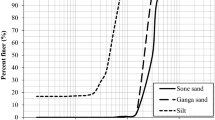In the study of liquefaction potential, most researchers have focused on clean sand. Reports from studies on silty sand and silt are rare; thus, different aspects of the subject are not well known. The present investigation uses cyclic triaxial tests, the effect of factors such as the cyclic stress ratio (CSR), and the non-plastic finegrained soil content on the liquefaction of the silty sand and pure silt. The effect of the pressure applied to the soil structure in the saturation phase also was studied. The results indicate that an increase of 30% in the non-plastic fine silt content in the sand decreased the liquefaction resistance. An increase in the silt content to more than 30% increased the liquefaction resistance because, with an increase in the fines content up to 30%, sand governs the soil behavior and, with an increase in the fines content to more than 30%, silt governs the soil behavior. The effect of the CSR on the liquefaction of the samples was evident. Changes in the CSR and fines content produced changes in the maximum pore water pressure. The effect of the pressure applied to the soil structure in the saturation phase on pure silt was insignificant, but this difference was more prominent for silty sand and, to some extent, clean sand.
Similar content being viewed by others
References
L. R. Stavnitser and Z. S. Karpushina, “Dynamic triaxial tests of sandy soils,” Soil Mech. Found. Eng., 10, 42–45 (1973).
L. Chen, J. J. He, B. B. Yao, C. W. Lei, and Z. Zhang, “Influence of the initial relative density on the drained strength properties of soils subjected to internal erosion,” Soil Mech. Found. Eng., 56, 273–279 (2019).
A. F. Cabalar, M. Wiszniewski, and Z. Skutnik, “Effects of xanthan gum biopolymer on the permeability, odometer, unconfined compressive and triaxial shear behavior of a sand,” Soil Mech. Found. Eng., 54, 356–361(2017).
S. Miura, S. Kawamura, and K. Yagi, “Liquefaction damage of sandy and volcanic grounds in the 1993 Hokkaido Nansei-oki earthquake,” Proc. 3rd Int. Conf. on Recent Advances in Geotechnical Earthquake Engineering and Soil Dynamics, St. Louis, Missouri, 1, 193-196 (1995).
K. Ishihara, “Liquefaction and flow failure during earthquakes,” Geotechnique, 43, No. 3, 351-415 (1993).
J. H. Tronsco and R. Verdugo, “Silt content and dynamic behavior of tailing sands,” Proceedings, Twelfth Int. Conf. on Soil Mech. and Found. Eng., San Francisco, USA, 1311-1314 (1985).
J. A. Yamamuro and P. V. Lade, “Effect of non-plastic fines on static liquefaction of sands,” Can. Geotech. J., 34, 918-928 (1997).
N. Y. Chang, S. T. Yeh, and L. P. Kaufman, “Liquefaction potential of clean and silty sands,” Proc. 3rd Int. Earthquake Microzonation Conf., Seattle, USA, 2, 17–32 (1982).
J. P. Koester, “The influence of fine type and content on cyclic strength,” Ground Failures under Seismic Conditions, Geotech. Spec. Pub., ASCE, 44, 17-33 (1994).
C. P. Polito and J. R. Martin, “The effects of non-plastic fines on the liquefaction resistance of sands,” J. Geotech. Geoenviron., 127, No. 5, 408 (2001).
F. Amini and G. Z. Qi, “Liquefaction testing of stratified silty sands,” J. Geotech. Geoenviron., March, 126, No. 3,208 (2000).
B. K. Maheshwari and A. K. Patel, “Effects of non-plastic silts on liquefaction potential of solani sand,” Geotech. Geol. Eng., 28, 559–566 (2010), DOI https://doi.org/10.1007/s10706-010-9310-z.
E. Karakan, N. Tanrinian, and A. Sezer, “Cyclic undrained behavior and post liquefaction settlement of a nonplastic silt,” Soil Dyn. Earthq. Eng., 120, 214–227 (2019).
M. Akhila, K. Rangaswamy, and N. Sankar, “Effect of non-plastic fines on undrained response of fine sand,” Int. J. of Geomate, 16, No. 54, 170 – 175 (2019).
Author information
Authors and Affiliations
Corresponding author
Additional information
Translated from Osnovaniya, Fundamenty i Mekhanika Gruntov, No. 6, November-December, 2021.
Rights and permissions
About this article
Cite this article
Marzuni, S.S., Fadaee, M., Bahmanpour, A. et al. Effect of Cyclic Stress Ratio and Non-Plastic Fines Content on the Liquefaction Potential of Sandy and Silty Soil in Cyclic Triaxial Testing. Soil Mech Found Eng 58, 467–473 (2022). https://doi.org/10.1007/s11204-022-09768-w
Published:
Issue Date:
DOI: https://doi.org/10.1007/s11204-022-09768-w




